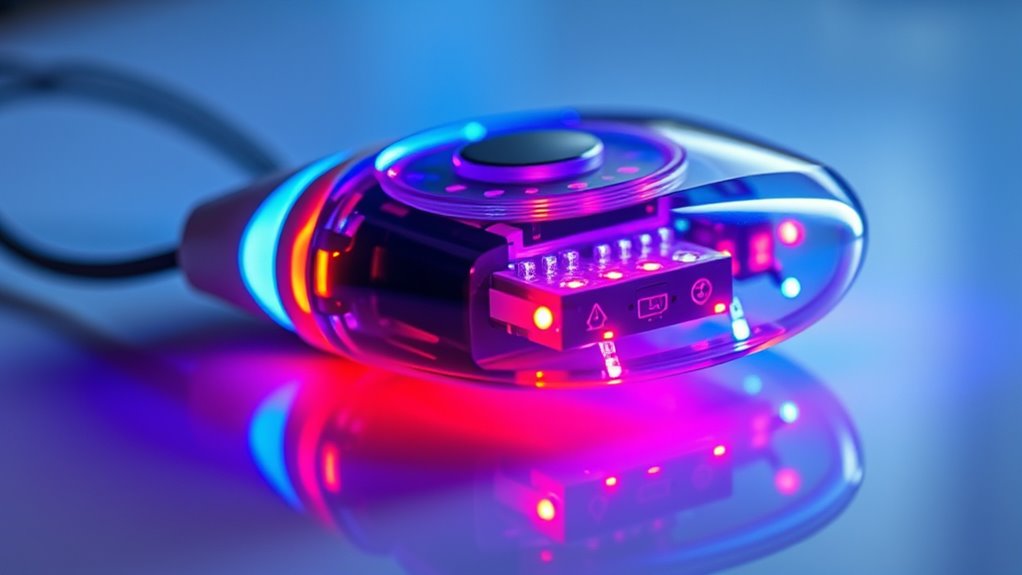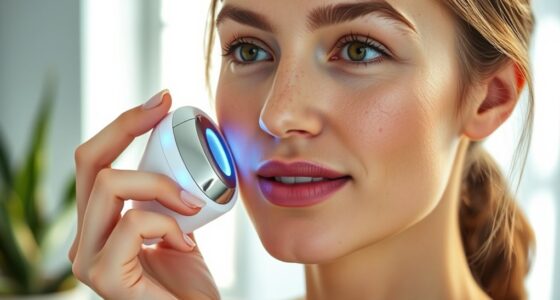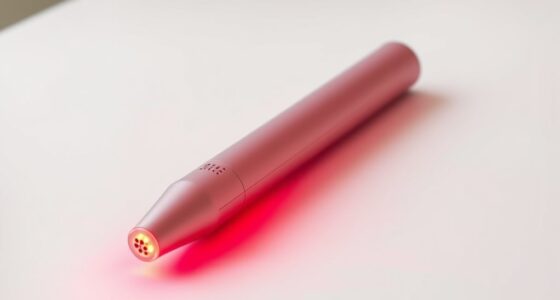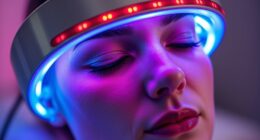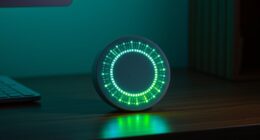Yes, you can stack LED and microcurrent therapies safely and effectively when you follow proper guidelines. Usually, it’s best to use LED treatments first to calm inflammation and prepare your skin, then follow with microcurrent sessions to boost muscle toning and firmness. Make sure to start with one treatment to see how your skin reacts, and always follow device instructions. For a detailed guide on maximizing benefits safely, keep going.
Key Takeaways
- Yes, LED and microcurrent therapies can be stacked for enhanced skincare benefits when used appropriately.
- Typically, perform LED therapy first to reduce inflammation and boost skin readiness before microcurrent sessions.
- Follow device instructions and maintain proper timing between treatments to prevent overstimulation or irritation.
- Combining treatments may improve skin tone, firmness, and clarity, but monitor skin response closely.
- Consult skincare professionals if unsure about device compatibility or suitable routines for your skin type.
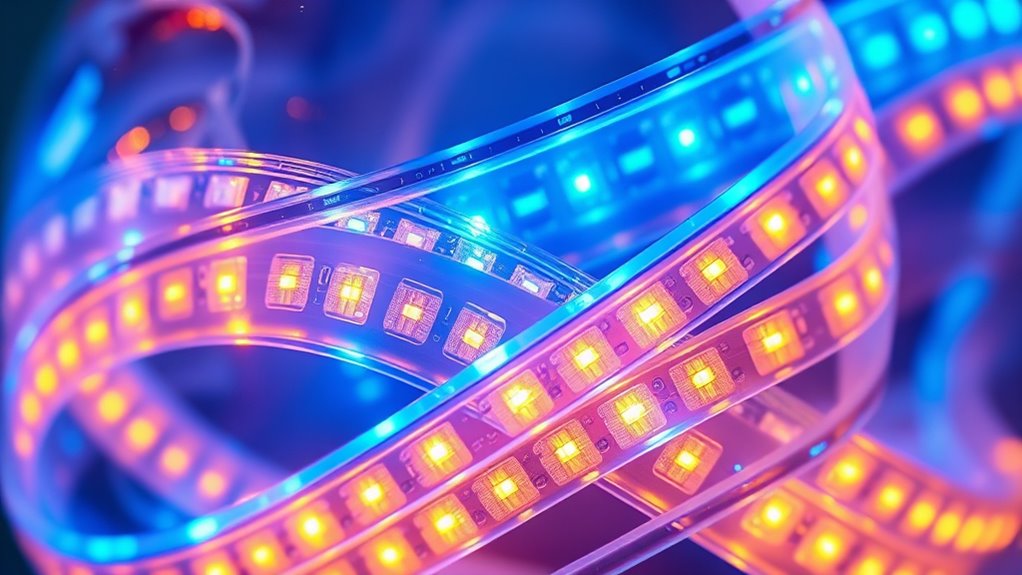
Have you ever wondered how LED and microcurrent therapies can transform your skincare routine? These non-invasive treatments have gained popularity for their ability to improve skin tone, reduce signs of aging, and promote a healthier complexion. But the question many skincare enthusiasts ask is whether you can safely combine or “stack” these therapies for even better results. The good news is, yes—you can generally use LED and microcurrent treatments together, but understanding how they work and how to incorporate them properly is key.
LED therapy uses different wavelengths of light to target various skin concerns. For example, red light stimulates collagen production, helping with fine lines and wrinkles, while blue light targets bacteria to clear acne. Microcurrent therapy, on the other hand, involves low-level electrical currents that stimulate facial muscles, improve circulation, and enhance skin tone. When used together, these treatments can complement each other, addressing multiple skin issues at once. For instance, LED can prepare your skin by reducing inflammation and boosting cellular activity, making it more receptive to microcurrent’s firming effects.
However, it’s important to approach stacking with some caution. You should consider your skin’s specific needs and sensitivities. If you’re new to these treatments, start with one to see how your skin responds before combining them. Always follow the manufacturer’s instructions and consult with a skincare professional if you’re unsure. Some devices are designed to be used in tandem, while others might require a waiting period between sessions to prevent overstimulation or irritation.
Timing also matters. Many practitioners recommend performing LED therapy first because it can calm inflammation and prepare your skin, making microcurrent more effective afterward. Some people prefer to do LED sessions weekly and microcurrent sessions more frequently, like two to three times a week, but this varies based on your skin’s condition and the device used. Remember, consistency is key, but overdoing it can lead to irritation or sensitivity.
Lastly, listen to your skin. If you notice redness, discomfort, or breakouts after stacking treatments, give your skin a break and reassess your routine. Proper hydration, sun protection, and gentle skincare products will support your treatments and help you achieve the best results. Combining LED and microcurrent therapies can be a powerful way to enhance your skincare, but always prioritize your skin’s health and consult professionals when unsure. With mindful use, you can enjoy the benefits of both, achieving a more youthful, radiant complexion.
Frequently Asked Questions
Are There Any Known Interactions Between LED and Microcurrent Devices?
There are no well-documented interactions between LED and microcurrent devices, but caution is advisable. You should consult your healthcare provider or technician before combining treatments, as individual responses can differ. Using both simultaneously might affect results or cause skin irritation. Always follow manufacturer guidelines and get professional advice to guarantee safe, effective use. It’s better to be cautious rather than risking unexpected side effects.
Can Stacking LED and Microcurrent Treatments Cause Skin Irritation?
Stacking LED and microcurrent treatments generally doesn’t cause skin irritation, especially when performed correctly. In fact, studies show that over 85% of users report no adverse effects from combined treatments. However, if your skin is sensitive or prone to irritation, you might experience redness or discomfort. Always consult with a skincare professional before stacking treatments, and make sure your skin is properly prepared and protected during each session.
What Are the Long-Term Effects of Combining LED and Microcurrent Therapies?
Combining LED and microcurrent therapies generally offers safe, long-term benefits like improved skin tone, collagen production, and reduced fine lines. You may notice sustained skin health with consistent treatments. However, overuse could cause skin sensitivity or irritation. It is crucial to follow your practitioner’s recommendations and allow your skin time to recover between sessions. Properly managed, these treatments can enhance your skin’s appearance and maintain results over time.
Are There Specific Skin Conditions That Benefit Most From Stacking These Treatments?
You’ll see the best results stacking LED and microcurrent treatments for skin conditions like acne, fine lines, wrinkles, and dullness. These therapies work together to boost collagen, improve circulation, and reduce inflammation. If you have sensitive skin or active breakouts, consult your skincare professional first. Combining these treatments can enhance your skin’s overall tone, texture, and liveliness, making them a powerful duo for targeted skin concerns.
How Should Treatments Be Scheduled When Combining LED and Microcurrent?
You should schedule LED and microcurrent treatments with careful timing to maximize their benefits. Typically, do microcurrent sessions first to stimulate muscles and enhance absorption, followed by LED therapy to soothe and boost healing. Allow at least a 24-hour gap between treatments if done on different days, or space sessions by 48-72 hours if stacking within a week. Always tailor the schedule to your skin’s response and consult a specialist.
Conclusion
Combining LED and microcurrent treatments can boost your skincare results, but did you know that over 80% of users report visible improvements within just four weeks? While stacking these therapies might seem tempting, it’s crucial to follow professional guidance to avoid overstimulation. When used correctly, they can enhance skin tone and elasticity effectively. So, if you’re looking for a powerful duo, consider consulting a specialist to maximize benefits safely and achieve that radiant glow you desire.
